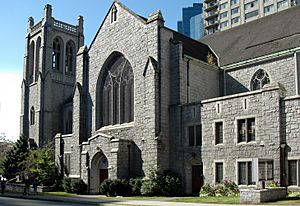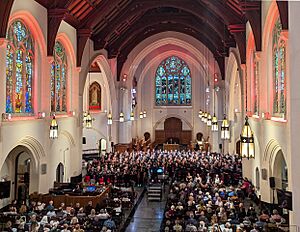St. Andrew's-Wesley United Church facts for kids
Quick facts for kids St. Andrew's-Wesley United Church |
|
|---|---|

St. Andrew's-Wesley United Church in 2008
|
|
| 49°16′53″N 123°07′36″W / 49.281250°N 123.126756°W | |
| Location | 1022 Nelson Street Vancouver, British Columbia V6E 4S7 |
| Language(s) | English |
| Denomination | United Church of Canada |
| Architecture | |
| Completed | 1933 |
St. Andrew's-Wesley United Church is a special church in Vancouver's downtown area. It is part of the United Church of Canada and first opened its doors in 1933. The church is famous for its beautiful design and artwork. A big restoration project started in 2019 to make it even better. Today, the church holds three services each week, including popular jazz music events.
Contents
How the Church Started
The story of St. Andrew's-Wesley United Church began with two different church groups: the Methodist and Presbyterian churches. These groups were active in the Greater Vancouver area.
Early Methodist Churches
On July 30, 1863, Reverend Ebeneezer Robson, a Methodist minister, held the first church service in Vancouver. It took place at Hastings Mill for six men. In 1875, a Methodist church was built on Water Street for Indigenous workers. Sadly, it was destroyed in the Great Vancouver Fire of 1886. The church was rebuilt, and later, the congregation moved to the Homer Street Church in 1889. Then, the Wesley Methodist Church was built in 1901 at Georgia and Burrard Streets.
Early Presbyterian Churches
Meanwhile, the local Presbyterian Church started near the Fraser River. Reverend Robert Jamieson traveled upriver and started a church on Sea Island. Later, Reverend T. G. Thompson began services in Vancouver. A Presbyterian church was built on Oppenheimer (now Cordova) Street. This building also burned down in the Great Fire of 1886. Another church was built on the same street, which was then replaced by a church at Hastings and Gore Streets. As more people joined, a larger church, St. Andrew's Presbyterian, opened in 1890 at Georgia and Richards Streets.
Joining Together
The Methodist and Presbyterian churches joined to form the United Church of Canada in 1925. This union also included Congregational and Local Union churches. In 1924, a group started planning to merge Wesley Methodist Church and St. Andrew's Presbyterian. In 1927, they voted to join. The first combined meeting happened in 1929. Funds from selling the Wesley Methodist church helped build the new St. Andrew's-Wesley United Church. It was built at Burrard and Nelson Streets and opened on May 26, 1933, to many people. The first minister was Bishop Willard Brewing.
Church Design and Art
The church was designed by the company Twizel & Twizel. Most of the building materials came from British Columbia. It was built using granite from Nelson Island and stone from Haddington Island. The church has a tall tower in the Gothic Revival style, which was popular in the late 1300s. The building is shaped like a cross, and inside, it has a beautiful arched wooden roof.
Stained Glass Windows
St. Andrew's-Wesley United Church has the most different kinds of stained glass windows in Vancouver. The first window was put in in 1935. It was ordered by Canada's Prime Minister, R. B. Bennett, to remember his sister, Evelyn Bennett Coates. The artist, Duncan Dearle, from London's William Morris & Company, designed the window above the altar, called The Sermon on the Mount. He also made ten other windows for the church.
In 1969, the church asked French artist Gabriel Loire to create the east window. This window was inspired by a Bible verse, "Go Ye into all the World." It is mostly blue, like windows from the Middle Ages. Loire also made six panels showing women from the Bible. He also drew designs for eight more windows, four with Old Testament themes and four with New Testament themes. These windows were installed in 1981. Unlike older windows made with leaded glass, Loire's windows used a stronger method called Dalle de verre. Other artists who designed stained glass for the church include Rupert Moore, Louise Duthie, and Lutz Haufschild.
Angel Sculptures
In the chancel (the area near the altar), there are four sculptures of angels. These angels are playing musical instruments: a flute, a cello, a trumpet, and cymbals. They remind people of a Bible verse about praising God with music. These sculptures were made in the late 1940s by Leonard Woods and are called The Angelic Symphony.
Building and Restoration
In 2000, the city of Vancouver allowed the church to build an apartment building. This building, called St. Andrew's Residence at Wesley Place, is 22 stories tall and has 199 homes. In 2019, the church property was worth a lot of money, about $85.7 million.
In 2019, the church closed for two years for a big restoration project. This work included making the building safer in case of an earthquake and putting on a new copper roof. The original plaster inside was repaired, and new stone floors and pews were installed. Ryder Architecture and RJC Engineers did the work. The organ was also fixed up. The renovations finished in 2021. This restoration project won a B.C. Heritage Award in 2021 and a Vancouver Heritage Conservation Award in 2023.
Working Towards Reconciliation
Between 1849 and 1969, the United Church of Canada ran many residential schools in Canada. In 1986, the church's leader, Reverend Robert Smith, apologized to Indigenous people for past wrongs. In 1998, the church made a more specific apology for its part in the residential school system, and they repeated this apology in 2018. The United Church of Canada has had two Indigenous leaders, Stan McKay and the current leader, Carmen Lansdowne.
In 1940, St. Andrew's-Wesley United Church put up a bronze plaque for Reverend Charles Montgomery Tate. He was a missionary who helped start the Coqualeetza residential school. In 2021, as a step towards reconciliation, the church asked Xwalacktun (Rick Harry), a Skwxwú7mesh (Squamish) carver, to redesign the plaque. Xwalacktun created a house post that includes the plaque in a respectful way. To mark this important event, the church invited Sam George, a Skwxwú7mesh elder and residential school survivor, to give a sermon.
Church Services and Events
In 2017, the church celebrated 25 years of its Sunday evening jazz vesper services. St. Andrew's-Wesley United Church also holds two other Sunday services. The church building is often used for concerts and is a popular place for filming television shows and movies.
See also


